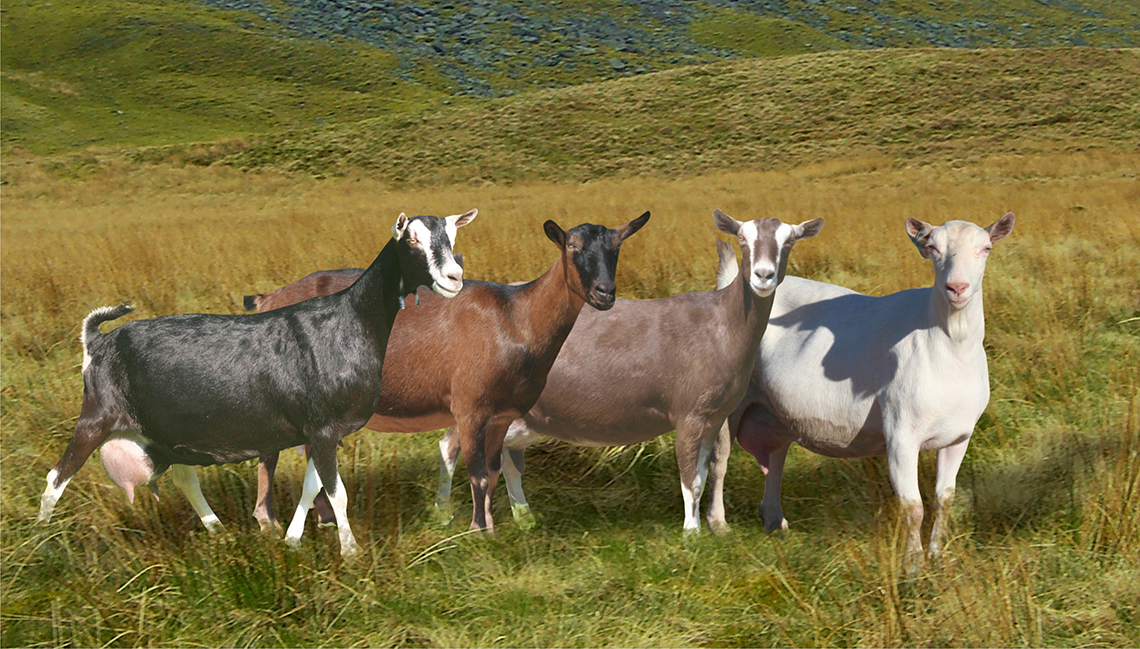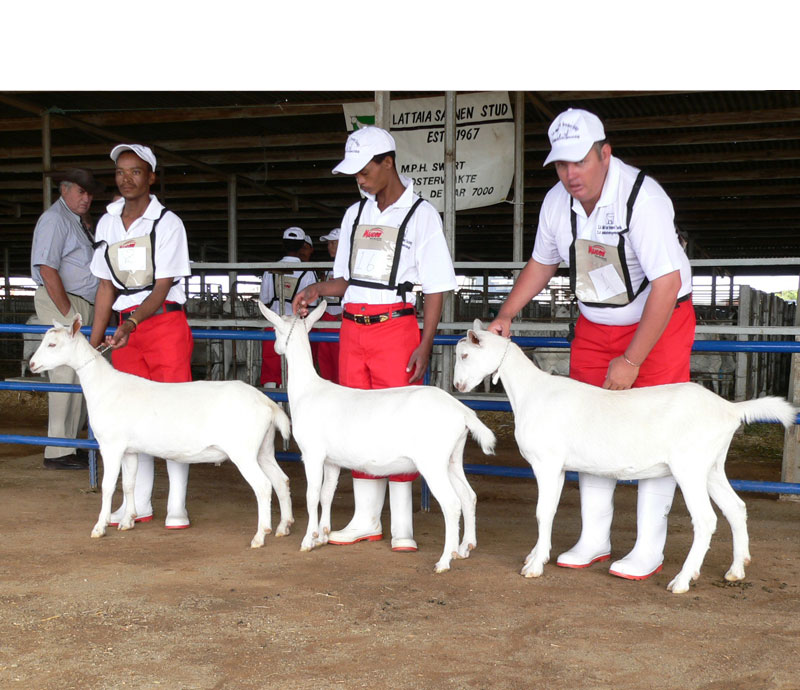
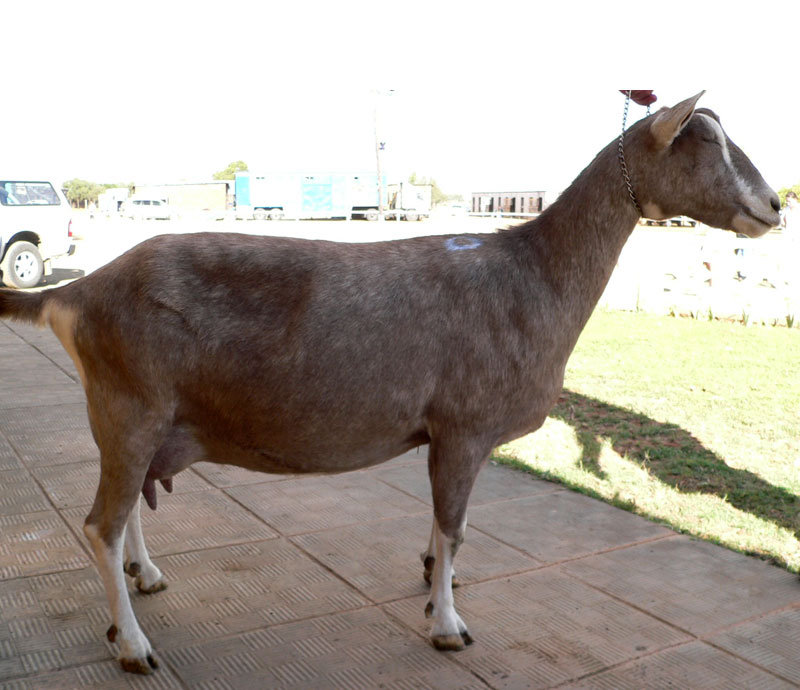
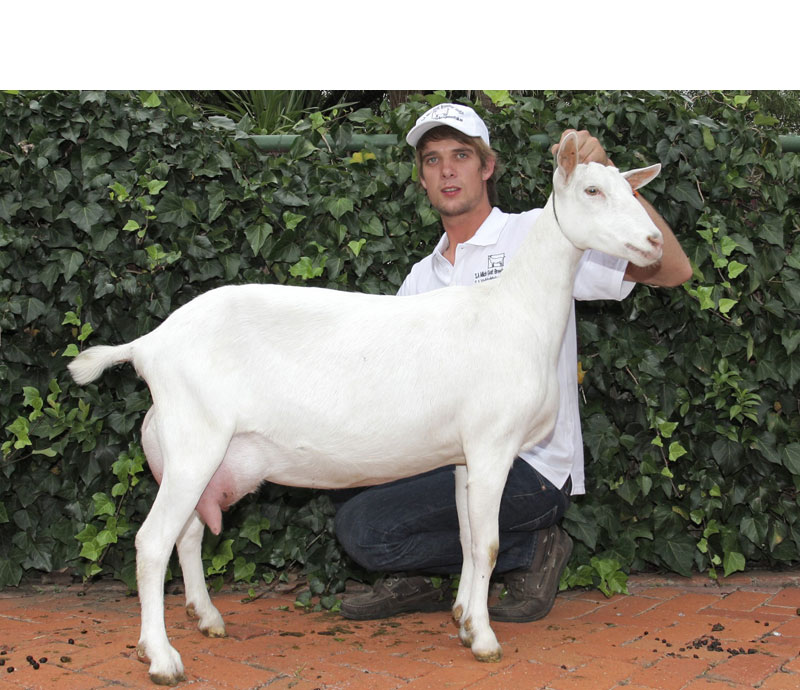
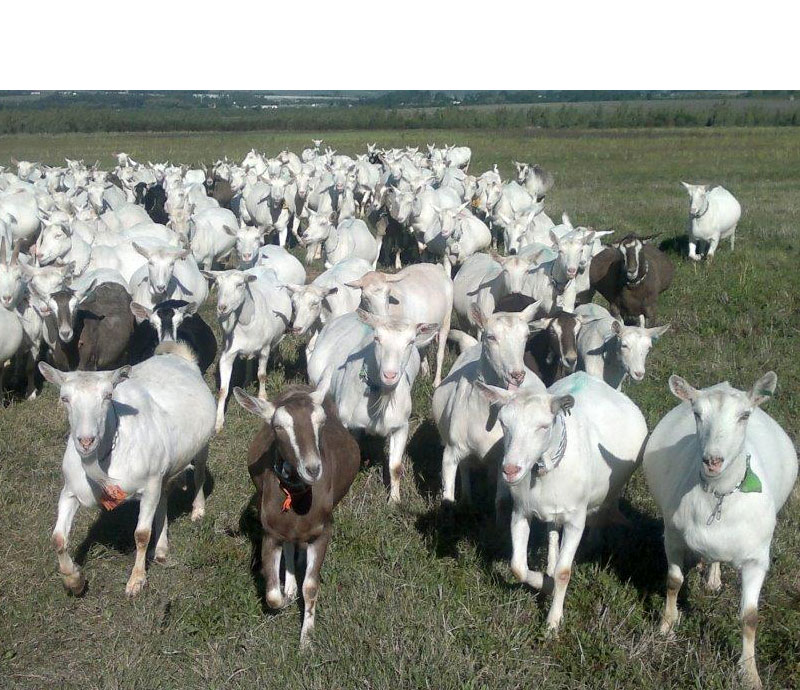
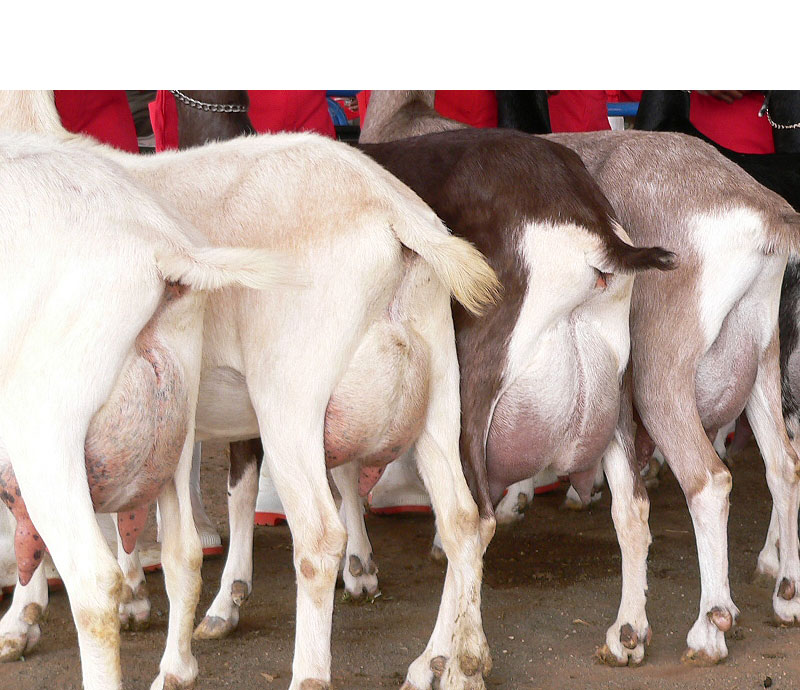
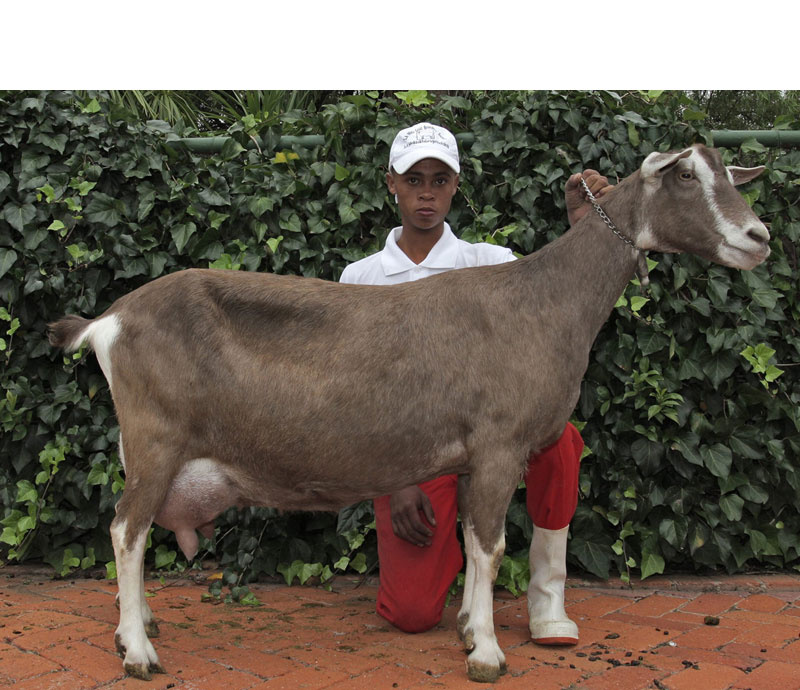
The first mention of South Africa’s goat dates back to nine years after the Dutch established a settlement at the Cape in 1652. An expedition was sent out on 30 January 1661 to explore the inland. It was reported that they rested in the vicinity of the Olifants River where the Namaqua prince presented them with a goat obtained from a bantu tribe called Briqua, i.e., "goat people"/ According to other explorers the goat in South Africa corresponded with the Nubian or Egyptian goat. Wallace reported in 1896 "that a small herd of milch goats and a huge number of goats are kept at Groot Constantia for manure for fertilizing the vineyards".
Goats do well in practically all environments as neither extreme cold nor heat affects them adversely. The milch goat’s advantage is that they can be kept for household purposes, often on poorer grazing where cows cannot be kept economically. Goat’s milk is used for babies allergic to cow’s milk, as well as for patients with digestive disorders. Goats are also free from tuberculosis.
On 3 July 1958 the SA Milch Goat Breeders’ Society was founded, and on 2 August 1958 a Certificate of Incorporation was issued to the Society. The total membership of the Society currently stands at 28 active breeders.
During 1898 the Cape Agricultural Department imported three Saanen males and twelve females, probably from Switzerland. The South African Milch Goat Association was founded in 1926 and affiliated to both the then SA Stud Book Association and British Goat Society.
The colour of the Saanen is white with no markings, although black spots on the nose, eyelids and ears are an advantage in differing from the undesirable albino. The only drawback to the fair-skinned Saanen is that the harsh South African sun causes skin carcinomas of the udder, while the Toggenburg and British Alpine do not have this problem. Two Saanen males and fifteen females, with milk production varying between 3,75 and 7,5 litres per day, were imported from Switzerland to South Africa in the early 1900s.
These goats had been bred by careful selection for many centuries in their country of origin but, unfortunately, no immediate and official attempt was made to keep them pure in South Africa.
The present-day Saanen in South Africa originated from one male and one female imported from Germany in 1923, as well as from other importations from Switzerland, England and Germany between 1923 and 1976. Various breeders registered animals, yet none of these was transferred and they could not be traced in 1947 when a Mr PR du Preez wanted to make a fresh start with registered goats. The only breeder with registered goats at the time owned only two females. Mr. du Preez bought one of them and had to import a male from England to serve this female, as there were no others available. From 1958 to 1985, the SA Stud Book and livestock Improvement Association (SASBLIA) registered 2388 Saanen females and 530 Saanen males, whilst 139 females and 42 males were registered from 1985 to 1991. Today 432 Saanen females and 120 Saanen males are registered in South Africa.
The home of this breed is the Toggenburg Valley in the Swiss Alps. The fertile valleys are separated from one another by steep mountain ranges. These natural and formidable partitions assisted towards the development of a pure breed. The Toggenburg’s colour may vary from fawn to dark chocolate with white marking similar to those of the British Alpine. The pure Toggenburg was developed in Switzerland, while the British Toggenburg was bred in Britain; thus indicating that other blood lines may have been introduced to the pure Toggenburg imported from Switzerland to Britain.
Pure Toggenburgs came to South Africa early in the 20th century, but again none was registered here. Some good milkers were the result of crossbreeding with South African-type milch goats originating from the pure Saanen importations of 1900 to 1914. For almost 20 years no Toggenburgs were registered in South Africa and all the old bloodstock disappeared. In 1951, Mr W H Morris of Cape Town imported a pure Toggenburg male and two females in kid from Switzerland. From 1934 to 1951 two pure Toggenburg females and 18 males were registered directly, while from 1959 to 1985 the Society applied for the registration of 167 females and 58 males. Today 21 Toggengburg females and eight Toggenburg males are registered in South Africa.
The body of the British Alpine goat is black with white markings. White facial stripes stretch from above the eyes to the muzzle, while the edges and tips of ears, legs from the hocks and knees downwards, and both sides of the tail are also white. The contrasting colour markings make this breed striking in appearance. Breeders in South Africa fancied the black-and-white goats bred by a Mrs Abbey in England. An attempt was made by enthusiast in and around Johannesburg to copy the image of the British Alpine, by interbreeding dark brown Toggenburgs. South Africa’s first black-and-white Swiss–type male was born in August 1923 and registered with the then SA Stud Book Association. Breeders contemplated importing British Alpine goats, but a joint consignment destined for the Government and the Society was stopped in 1924 due to an outbreak of foot-and-mouth disease in England. Although the hopes of would-be breeders were shattered by this event, a small Appendix herd was kept in and around Johannesburg. The owners propagated the breed by showing them at Johannesburg, Pretoria, Bloemfontein and Port Elizabeth and entering them for milking competitions. Between 1924 and 1934 six females and three males, all of them bred from excellent milkers, were imported.
Teen die einde van die 19de Eeu was daar in verskillende dele van Duitsland in klein hoeveelhede en op afgesonderde plekke melkbokke aangehou. Dit het tot gevolg gehad dat verskillende eenvormige kleurpatrone, eienskappe en kwaliteite in geharde omstandighede vasgeteel was.
In 1928 het die getalle bokke in Duitsland baie afgeneem. Die Duitse Melkboktelersgenootskap het toe besluit om alle gekleurde bokke onder een naam te plaas, nl; Bunte Deutsche Edelziege, om `n groter genepoel te verkry.
Die Bunte Deutsche Edelziege (hierna die BDE genoem) is in Duitsland geteël hoofsaaklik uit drie groepe melkbokke wat elkeen op `n unieke wyse ontstaan het. Thüringer Waldziege (forest goat), Harzziege en die Erzgebirgziege.
Die BDE het dus nie `n vaste definitiewe kleurpatroon nie. Dit kan varieer vanaf ligbruin, vaalbruin, grysbruin tot donker roesbruin. Hulle het `n swart of donkerbruin dorsale streep op die rug (van die nek tot by die stert) Die vel van die BDE (onder die hare) is swart en is dus baie goed gepigmenteerd. Die bene en pens wissel van lig tot swart.
Unieke kenmerke
Huidiglik is daar 28 ooie en 8 ramme in Suid Afrika geregistreerd.
Oorsprong van die BDE
Die Thüringer Waldziege, donker bruin van kleur, het ontstaan deurdat hulle `n goed gepigmenteerde Franse swart bok met Toggenburgs gekruis het. Hierdie kruising het dan as Thüringer Toggenburgs bekend gestaan. Die Thüringer Waldziege is baie geharde bokke wat in baie moeilike omstandighede, koue winters, hoë reënval in die woud kon aanpas en oorleef.
Die Harzziege was hoofsaaklik deur die mynwerkers gebruik as die “arm man se koei” Die Harzziege was `n vaalbruin, korthaar bok met `n ligte kleur maag en `n swart dorsale streep op die rug. Dit was `n robuuste en baie geharde bok met baie goeie weerstand teen siektes.
Die Erzgebirgziege het ontstaan uit verskillende variasies van grysblou, swart en bont bokke. Hierdie bokke is weer gekruis met gekleurde rasse van Switzerland. Uit hierdie teëling het `n vaalbruin bok ontstaan met `n swart dorsale streep , swart maag en swart bene. Die Erzgebirgziege verskil min van die gekleurde Franse bok, maar was kleiner en het `n laer melkproduksie gehad. Die Erzgebirgziege is toenemend met die Franse bokke gekruis om hoër melkproduksie te verkry.
